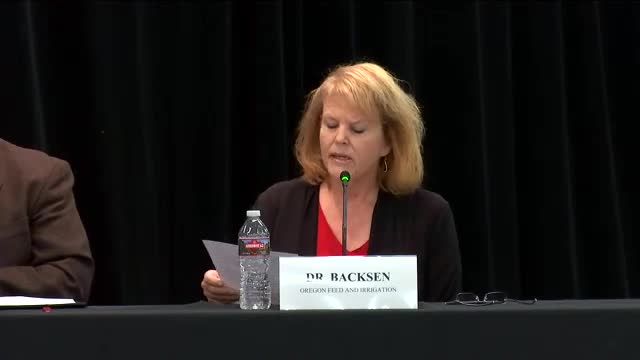Central Oregon farmers face water crisis threatening livelihoods and agricultural sustainability
December 31, 2024 | Natural Resources: House Committee, Standing Committees - House & Senate, Congressional Hearings Compilation
This article was created by AI summarizing key points discussed. AI makes mistakes, so for full details and context, please refer to the video of the full meeting. Please report any errors so we can fix them. Report an error »

The U.S. House Committee on Natural Resources convened on December 31, 2024, to address critical issues surrounding water supply in Central Oregon, with a focus on the agricultural sector's struggles amid ongoing drought conditions. The meeting highlighted the urgent need for improved water management strategies to support local farmers and businesses.
One of the key testimonies came from a local business owner who operates Haystack Farm and Feed in Culver, Oregon. The owner detailed the severe challenges faced by agricultural enterprises in the region, including rising costs for labor, fuel, and essential supplies, compounded by a significant water shortage. The testimony underscored that many farms are on the brink of closure due to these pressures, with property values declining and generational farms disappearing.
The owner emphasized the unique agricultural contributions of Central Oregon, noting its role as a leading producer of carrot seed and wildflower seed, which is vital for attracting monarch butterflies, a species facing potential endangerment. However, the ongoing water crisis has drastically reduced irrigation availability, with farmers receiving only half of their traditional water allotment. This has severely limited crop production, with only 400 to 600 acres of the 1,200 acres farmed being harvestable in a given year.
The meeting also addressed the broader implications of water scarcity, which not only threatens agriculture but also impacts the region's tourism industry, known for its scenic beauty and outdoor recreation opportunities. The owner expressed gratitude for the efforts of local representatives in securing federal resources aimed at improving water delivery systems and conservation efforts. However, the lengthy and costly process of implementing these solutions poses a significant risk to farmers who may not survive the wait.
In conclusion, the committee's discussions highlighted the critical intersection of water management and agricultural sustainability in Central Oregon. The urgent need for effective solutions was clear, as the future of local farming—and by extension, food production—hangs in the balance. The meeting concluded with a call for continued collaboration among stakeholders to address these pressing water challenges.
One of the key testimonies came from a local business owner who operates Haystack Farm and Feed in Culver, Oregon. The owner detailed the severe challenges faced by agricultural enterprises in the region, including rising costs for labor, fuel, and essential supplies, compounded by a significant water shortage. The testimony underscored that many farms are on the brink of closure due to these pressures, with property values declining and generational farms disappearing.
The owner emphasized the unique agricultural contributions of Central Oregon, noting its role as a leading producer of carrot seed and wildflower seed, which is vital for attracting monarch butterflies, a species facing potential endangerment. However, the ongoing water crisis has drastically reduced irrigation availability, with farmers receiving only half of their traditional water allotment. This has severely limited crop production, with only 400 to 600 acres of the 1,200 acres farmed being harvestable in a given year.
The meeting also addressed the broader implications of water scarcity, which not only threatens agriculture but also impacts the region's tourism industry, known for its scenic beauty and outdoor recreation opportunities. The owner expressed gratitude for the efforts of local representatives in securing federal resources aimed at improving water delivery systems and conservation efforts. However, the lengthy and costly process of implementing these solutions poses a significant risk to farmers who may not survive the wait.
In conclusion, the committee's discussions highlighted the critical intersection of water management and agricultural sustainability in Central Oregon. The urgent need for effective solutions was clear, as the future of local farming—and by extension, food production—hangs in the balance. The meeting concluded with a call for continued collaboration among stakeholders to address these pressing water challenges.
View full meeting
This article is based on a recent meeting—watch the full video and explore the complete transcript for deeper insights into the discussion.
View full meeting